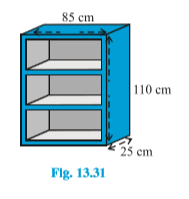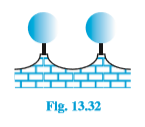NCERT Solutions for Exercise 13.9 Class 9 Maths Chapter 13 - Surface Area and Volumes
NCERT Solutions for Class 9 Maths exercise 13.9 is an optional last exercise which covers all of the topics from the whole chapter, including Surface Areas And Volumes of cylinder, sphere, etc…. In exercise 13.9 Class 9 Maths, The cuboid is a three-dimensional figure defined by six rectangular planes with different magnitudes of length, width, and height. It has eight vertices and twelve edges, and opposite faces are always equal. Also a sphere is a three-dimensional object that is circular in shape. The cuboid has two different types of surface area. They are lateral surface area and total surface area. Similarly, The surface area of a sphere refers to the overall area covered by its surface in three-dimensional space.
This Story also Contains
- Surface Area and Volumes Class 9 Maths Chapter 13 Exercise: 13.9
- More About NCERT Solutions for Class 9 Maths Exercise 13.9
- Benefits of NCERT Solutions for Class 9 Maths Exercise 13.9
- NCERT Solutions of Class 10 Subject Wise
NCERT solutions for Class 9 Maths chapter 13 exercise 13.9 include three questions that are not crucial for the examination but will help to improve geometrical concepts and creative thinking skills, which will be a useful addition to mathematical knowledge. The following exercises are also present along with NCERT book Class 9 Maths chapter 13 exercise 13.9.
- Surface Area and Volumes Exercise 13.1
- Surface Area and Volumes Exercise 13.2
- Surface Area and Volumes Exercise 13.3
- Surface Area and Volumes Exercise 13.4
- Surface Area and Volumes Exercise 13.5
- Surface Area and Volumes Exercise 13.6
- Surface Area and Volumes Exercise 13.7
- Surface Area and Volumes Exercise 13.8
Surface Area and Volumes Class 9 Maths Chapter 13 Exercise: 13.9

Answer:
External dimension od the bookshelf = $85\ cm\times25\ cm\times110\ cm$
(Note: There is no front face)
The external surface area of the shelf = $lh + 2 (lb + bh)$
$\\ = [85 \times 110 + 2 (85 \times 25 + 25 \times 110)] \\ = (9350 + 9750) \\ = 19100\ cm^2$
We know, each stripe on the front surface is also to be polished. which is 5 cm stretch.
Area of front face = $[85 \times 110 - 75 \times 100 + 2 (75 \times5)]$
$\\ = 1850 + 750 \\ = 2600\ cm^2$
Area to be polished = $(19100 + 2600) = 21700\ cm^2$
Cost of polishing $1\ cm^2$ area = $Rs\ 0.20$
Cost of polishing $21700\ cm^2$ area = $Rs.\ (21700 \times 0.20) = Rs.\ 4340$
Now,
Dimension of inner part = $75\ cm\times15\ cm\times100\ cm$
Area to be painted in 3 rows = $3\times[2 (l + h) b + lh]$
$\\ =3\times [2 (75 + 30) \times 20 + 75 \times 30] \\ = 3\times[(4200 + 2250)] \\ = 3\times6450 \\ = 19350\ cm^2$
Cost of painting $1\ cm^2$ area = $Rs\ 0.10$
Cost of painting $19350\ cm^2$ area = $Rs.\ (19350 \times 0.10)= Rs.\ 1935$
Total expense required for polishing and painting = $Rs.\ (4340 + 1935)$
$= Rs.\ 6275$

Answer:
Given,
The radius of the wooden spheres = $r_1 = \frac{21}{2}\ cm$
$\therefore$ The surface area of a single sphere = $4\pi r_1^2$
$\\ = 4\times\frac{22}{7}\times\frac{21}{2}\times\frac{21}{2} \\ = 22\times3\times21$
$= 1386\ cm^2$
Again, the Radius of the cylinder support = $\small r_2 = 1.5\hspace{1mm}cm$
Height of the support = $h = 7\ cm$
$\therefore$ The base area of the cylinder = $\pi r_2^2 = \frac{22}{7}\times1.5\times1.5 = 7.07\ cm^2$
Now, Cost of painting $1\ cm^2$ silver = $25\ paise = Rs.\ 0.25$
$\therefore$ Cost of painting 1 wooden sphere = Cost of painting $(1386-7.07)\ cm^2$ silver
= $Rs. (0.25\times1378.93) = Rs.\ 344.7325$
Now, Curved surface area of the cylindrical support = $2\pi r_2 h$
$\\ = 2\times\frac{22}{7}\times1.5\times7 \\ = 22\times3 \\ = 66\ cm^2$
Now, Cost of painting $1\ cm^2$ black = $5\ paise = Rs.\ 0.05$
$\therefore$ Cost of painting 1 such stand = Cost of painting $66\ cm^2$ silver = $Rs. (0.05\times66) = Rs.\ 3.3$
$\therefore$ The total cost of painting 1 sphere and its support = $Rs.\ (344.7325+3.3) = Rs.\ 348.0325$
Therefore, total cost of painting 8 such spheres and their supports = $Rs.\ (8\times348.0325) = Rs.\ 2784.26$
Answer:
Let the radius of the sphere be $r$
Diameter of the sphere = $2r$
According to question,
Diameter is decreased by $\small 25\%$
So, the new diameter = $\frac{3}{4}\times2r = \frac{3r}{2}$
So, the new radius = $r' = \frac{3r}{4}$
$\therefore$ New surface area = $4\pi r'^2 = 4\pi (\frac{3r}{4})^2$
$\therefore$ Decrease in surface area = $4\pi r^2 - 4\pi (\frac{3r}{4})^2$
$= 4\pi r^2[1 -\frac{9}{16} ]$
$= 4\pi r^2[\frac{7}{16} ]$
$\therefore$ Percentage decrease in the surface area = $\frac{Difference\ in\ areas}{Original\ surface\ area}$
$= \frac{4\pi r^2[\frac{7}{16}]}{4\pi r^2}\times100 \%$
$= \frac{7}{16}\times100 \%$
$= 43.75 \%$
More About NCERT Solutions for Class 9 Maths Exercise 13.9
In NCERT solutions for Class 9 Maths exercise 13.9, The cuboid’s total surface area may be computed by summing the areas of the 6 rectangular faces, where the area is calculated by multiplying the length and breadth of each surface. 2(lb + bh + hl) = TSA. A cuboid’s lateral surface area can be computed by summing the four planes of a rectangle and subtracting the upper and lower surfaces. 2h(l + b) = LSA. The product of four times the area of the circle is used to compute the sphere’s surface area. A=4πr2. A cube is a three-dimensional shape with six faces, eight vertices, and twelve edges that has the same length, width, and height. The cube’s surface area is 6a2, where a is the length of one of its sides.
Also Read| Surface Areas And Volumes Class 9 Notes
Benefits of NCERT Solutions for Class 9 Maths Exercise 13.9
• NCERT solutions for Class 9 Maths exercise 13.9 helps in solving the application level complex problem in an easy way and get sufficient practice to solve the questions confidently.
• By solving the NCERT solution for Class 9 Maths chapter 13 exercise 13.9 exercises, we can get an overall understanding of the concepts and helps us to be familiar with the different types of questions in the exam
• Exercise 13.9 Class 9 Maths, helps to increase your accuracy and speed in solving problems.
Also, See:
NCERT Solutions of Class 10 Subject Wise
Courses After 12th
Applications for Admissions are open.
As per latest syllabus. Physics formulas, equations, & laws of class 11 & 12th chapters
JEE Main Important Chemistry formulas
Get nowAs per latest syllabus. Chemistry formulas, equations, & laws of class 11 & 12th chapters
JEE Main high scoring chapters and topics
Get nowAs per latest 2024 syllabus. Study 40% syllabus and score upto 100% marks in JEE
JEE Main Important Mathematics Formulas
Get nowAs per latest syllabus. Maths formulas, equations, & theorems of class 11 & 12th chapters
